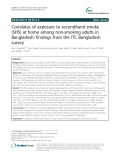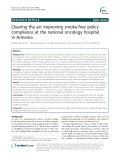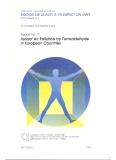
Tobacco smoke pollution
-
As part of an investigation into the respiratory health in children conducted in Torino, northwestern Italy, our aim was to assess development in lung function from childhood to adolescence, and to assess changes or persistence of asthma symptoms on the change of lung function parameters.
 8p
8p  vimontana2711
vimontana2711
 05-04-2021
05-04-2021
 13
13
 1
1
 Download
Download
-
Exposure to secondhand smoke (SHS) is a serious global public health problem. Understanding the correlates of SHS exposure could guide the development of evidence based SHS exposure reduction interventions.
 11p
11p  vimontana2711
vimontana2711
 05-04-2021
05-04-2021
 19
19
 2
2
 Download
Download
-
Smoke-free policies shown to reduce population exposure to secondhand smoke (SHS) are the norm in hospitals in many countries around the world. Armenia, a transition economy in the South Caucasus, has one of the highest male smoking rates in the European region.
 7p
7p  vialabama2711
vialabama2711
 21-09-2020
21-09-2020
 7
7
 0
0
 Download
Download
-
Several environmental factors favour the occurrence of acute respiratory disease, which is the main reason for paediatric consultations in our country (Colombia). Tobacco smoke is considered a significant environmental pollutant with a great impact on health.
 6p
6p  vimanama2711
vimanama2711
 28-07-2020
28-07-2020
 9
9
 1
1
 Download
Download
-
Population groups that are potentially more vulnerable than others to indoor air pollution are children, pregnant women, elderly people, and people suffering from cardiovascular or respiratory diseases. Depending on their age, children may be more vulnerable than adults to certain toxic substances, like lead and tobacco smoke. Even at low levels, air pollutants may disrupt the development of their lungs, cause cough, bronchitis and other respiratory diseases, and make asthma worse.
 6p
6p  doipassword
doipassword
 01-02-2013
01-02-2013
 45
45
 5
5
 Download
Download
-
When inhaled, carbon monoxide reacts very rapidly with hemoglobin in the blood, preventing uptake and transport of oxygen. Because carbon monoxide readily and firmly attaches to hemoglobin, it stays in the blood for a relatively long time. Thus, during an exposure carbon monoxide concentrations in blood can rise in a matter of minutes, then stay high for hours.
 17p
17p  doipassword
doipassword
 01-02-2013
01-02-2013
 46
46
 3
3
 Download
Download
-
The major sources of indoor air pollution worldwide include indoor combustion of solid fuels, tobacco smoking, outdoor air pollutants, emissions from construction materials and furnishings, and improper maintenance of ventilation and air conditioning systems. Although some indoor air pollutants, such as environmental tobacco smoke, are of concern globally, profiles of indoor air pollutants and the resulting health risks are generally very different in developed and developing countries.
 15p
15p  doipassword
doipassword
 01-02-2013
01-02-2013
 70
70
 6
6
 Download
Download
-
As noted above, there is no known exposure threshold for the risks of benzene exposure. Therefore, from a practical standpoint, it is expedient to reduce indoor exposure levels to as low as possible. This will require reducing or eliminating human activities that release benzene, such as smoking tobacco, using solvents for hobbies or cleaning, or using building materials that off-gas benzene. Adequate ventilation methods will depend on the site of the building.
 0p
0p  saimatkhauroi
saimatkhauroi
 01-02-2013
01-02-2013
 49
49
 3
3
 Download
Download
-
Approximately 75% of COPD cases are attributed to cigarette smoking (5). Occupation-related exposures may account for another 15% of COPD cases (6) and genetic factors, asthma, respiratory infections, and indoor and outdoor exposures to air pollutants also play a role (6,7). hus, COPD largely can be prevented. Prevention of COPD begins with reducing and/ or eliminating smoking initiation among teenagers and young adults and encouraging tobacco cessation among current smokers.
 18p
18p  chiecxedien
chiecxedien
 03-01-2013
03-01-2013
 54
54
 2
2
 Download
Download
-
Asthma is now the most common chronic childhood disease, occurring in approximately 54 of every 1000 children (21). From 1980 through 1996, childhood asthma increased dramatically, by approximately 5% per year (14, 16, 26). The etiology of asthma is complex and multifactorial; risk factors include genetic predisposition as well as exposure to environmental and infectious triggers.
 26p
26p  connhobinh
connhobinh
 10-12-2012
10-12-2012
 61
61
 1
1
 Download
Download
CHỦ ĐỀ BẠN MUỐN TÌM






















